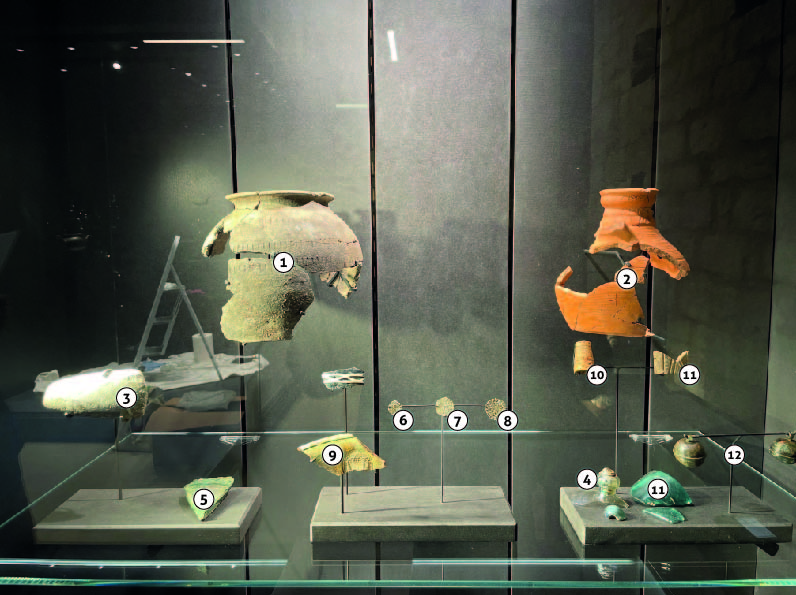ARCHEOLOGICAL EXCAVATIONS
Since 2009, regular historic research and excavations have taken place at the Penne Castle site. And since 2019, the research has been part of a Collective Research Programme: history, art history, land surveying, excavation in wide areas of the site and light detection and ranging (or Lidar) using lasers. A whole host of techniques and methods have been used to gradually rediscover and highlight over one thousand years of history, from 1000 AD to today.
This iconic site has changed in shape and occupation over time. Preliminary studies helped us target the most interesting areas linked to our archaeological orientations.
Every year, over 25 people carry out painstaking research over a period of 3 to 4 weeks. Specialised archaeologists, historians, archaeology students and enthusiastic volunteers join together to uncover the secrets buried in the fortress. Year after year, we have studied and analysed a range of hypotheses, leading us to launch a new period of excavations in a more targeted way.
Discovering a church at the site’s eastern point was one of the highlights of our research programme. A fragment from a reliquary vase found there (exhibited in the display case opposite) and signs of human settlement from 1000 AD brought this particular area to light. This was a particularly fascinating discovery, as was its destruction during the French Revolution.
Another important discovery: we found that during the 2nd half of the 14th century, the « Capetian » castle was reorganised for defensive purposes, as shown my major changes in different areas. In particular, the inhabitants of Penne began to hide their belongings in the north-western tip of the castle (niches can be seen on the « Bonshommes Path » which starts from the castle’s outer courtyard).
Of course, our exploration has not stopped there, and we are delighted to see objects from our excavations on display in the castle, helping to introduce you to part of its history down the ages.


Pot with rouletted decoration
- 12th century
- Grey ceramic
- Penne Castle – courtyard area
A pot (oule in French) curving outwards with a rounded lip and an opening diameter of 13 cm.
We can see three horizontal stripes containing lines made with rouletted decoration*. The roulette is a wheel, with or without teeth, used to decorate pottery before it is fired.
*To make an embossed or hollow imprint using a specific tool.

Small jug
- Late 13th-early 14th century
- Red ceramic with oxidation after firing
- Penne Castle – church area
Vase with large belly for containing liquids. A well-crafted piece with a narrow neck and an opening of 6 cm in diameter. The beginning of a ribbon-shaped handle at the base of the neck that looks like an original example of late polished ceramics. Wave design engraved at the neck.

Polished axe
- Neolithic (about 6,000 to 2,200 B.C.)
- Hornfels* or hard schist
- Penne Castle – courtyard area
This axe may have been left over from the Neolithic period or was found and used by people in the Middle Ages. It was discovered at an excavation site dating from the late 12th century or very early 13th century.
* Quartz similar to flint and used to make tools in the Neolithic period.

Bell fragment
- 15th century
- Copper alloy
- Penne Castle – church area

Fragment of reliquary vase
- 10th-11th century
- Natron-based glass
- Penne Castle – church area
This fragment of a reliquary vase is made of purple glass (coloured with manganese and copper) and decorated with white glass that was opacified using a mixture of calcium antimonate and tin oxide.

Obol from the County of Toulouse issued by the Counts Raymond V, VI and VII
- Between 1148 and 1249
- Silver
- Diam. 14mm
- Penne Castle – courtyard area

Carlin* or half-groschen from Comtat Venaissin issued by Pope Innocent VIII
- Between 1484 and 1492
- Silver
- Diam. 19mm
- Penne Castle – courtyard area
* An Italian coin with the value varying in different kingdoms.

Carlin or half-groschen from Comtat Venaissin issued by Pope Alexander VI
- Between 1492 and 1503
- Silver
- Diam. 21mm
- Penne Castle – courtyard area
* A papal state founded in 1274 and dissolved in 1791. It corresponds today to the south of Drôme and part of Vaucluse.

Fragment of a multi-coloured dish with a seal
- Between 1650 and 1710
- Ceramic painted with glaze*
- Penne Castle – north-eastern Castrum area
This decorative dish was made in Giroussens (Tarn). It features the archbishop’s seal.
* Special coating applied to some pottery and ceramics to add impermeability and a glossy effect.

Chess piece or ferrule*
- Late 12th-early 13th century
- Deer antler
- Ht. 30mm
- Penne Castle – courtyard area
The decoration alternates rows of dots and chevrons (upside-down V shapes), while the base features an embossed frieze with interlacing patterns and palmettes. This may be a rook chess piece with its cone shape.
* A small ring attached to a stick, a tool handle or a knife to prevent them from splitting.

Chess piece
- 11th-12th century
- Deer antler
- Ht. 23mm
- Penne Castle – courtyard area
A rook, half of which has been preserved, with a flat base to make it more stable. On the outer surface it has regular oblique markings. The inner surface has the spongy bone material of a deer’s antler.

Fragments of Grésigne glassware
- The pearl dates from before the 16th century
- Glass
- Penne Castle – church area
Hollow glass for practical or ornamental use (pearl).

Two bells
- 14th century
- Copper alloy
- Penne Castle – church area
Bivalve bells (formed by two pieces joined together) with two sheets of stamped metal.

